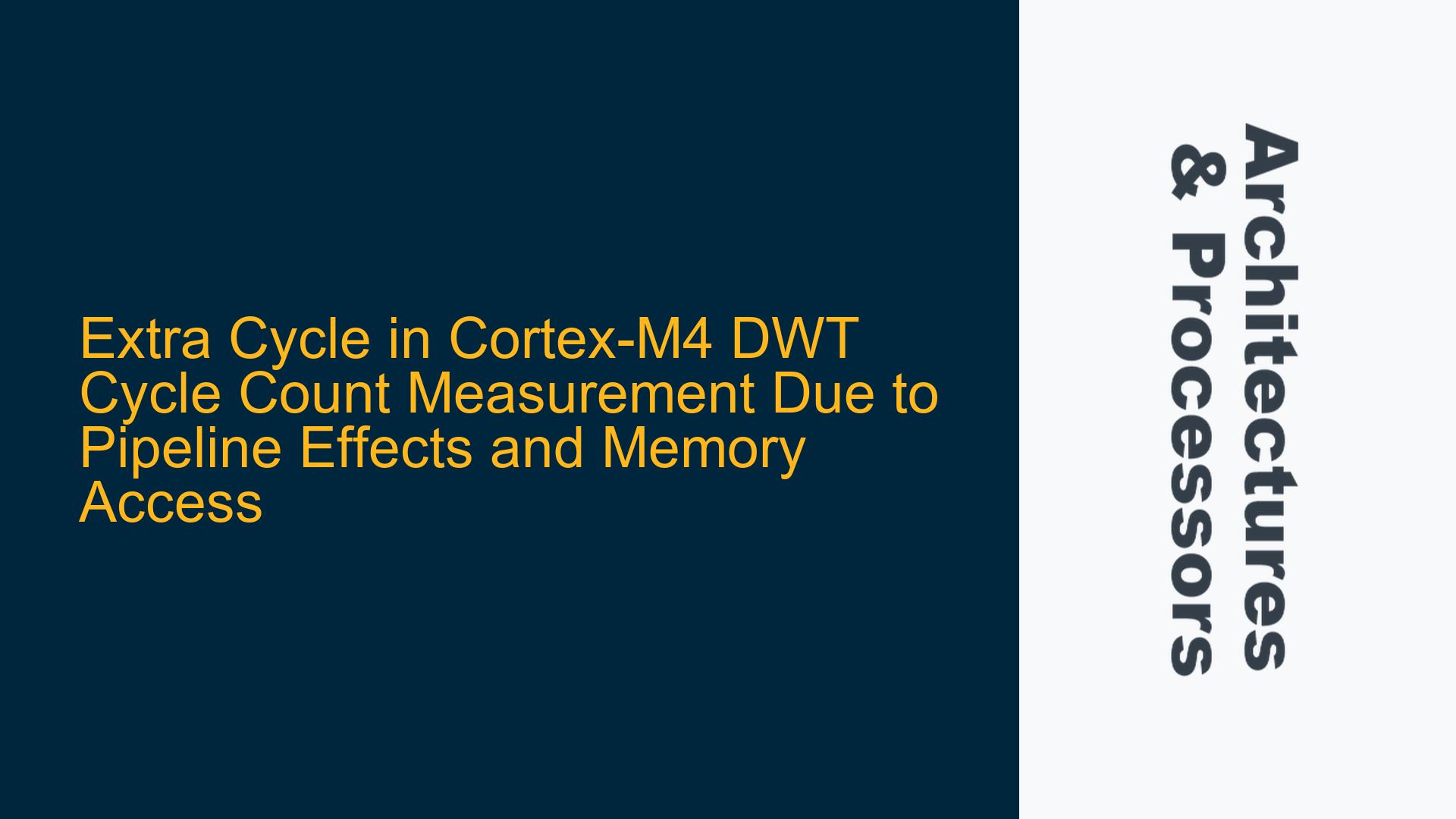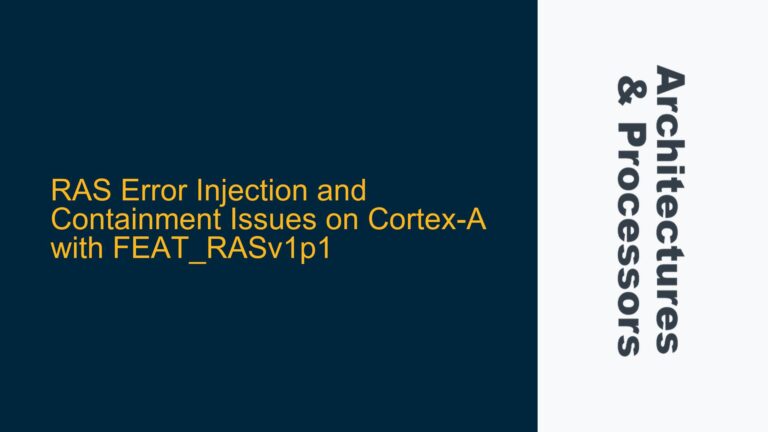Cortex-M4 Pipeline Behavior and DWT Cycle Counter Measurement Anomaly
The Cortex-M4 processor, like many modern microprocessors, employs a pipelined architecture to enhance performance. This architecture allows multiple instructions to be processed simultaneously, albeit at different stages of execution. While this design significantly boosts throughput, it introduces complexities when measuring precise instruction cycle counts, especially when using the Data Watchpoint and Trace (DWT) cycle counter. The DWT cycle counter is a hardware feature that increments with each CPU clock cycle, providing a high-resolution timer for performance measurement. However, its interaction with the pipeline and memory subsystems can lead to unexpected results, such as the observation of an extra cycle in measured instruction timings.
In the context of the Cortex-M4, the pipeline consists of several stages, including fetch, decode, execute, memory access, and writeback. Each stage operates independently but in a coordinated manner, allowing the processor to handle multiple instructions concurrently. However, this concurrency can lead to scenarios where the DWT cycle counter does not align perfectly with the intuitive expectation of instruction timing. For instance, when measuring the execution time of a simple ADD instruction, the pipeline’s behavior—such as instruction fetch delays, branch prediction, and data hazards—can introduce an additional cycle that is not immediately obvious.
Furthermore, the Cortex-M4’s interaction with memory, particularly when using an external accelerator like the STM32F429’s ART Accelerator, adds another layer of complexity. The ART Accelerator provides an instruction cache and prefetch mechanism, which can reduce wait states when accessing flash memory. However, this introduces variability in instruction fetch times, depending on whether the instruction is served from the cache or requires a fetch from flash. This variability can affect the DWT cycle counter’s accuracy, especially when measuring short sequences of instructions.
Pipeline Hazards and Memory Access Delays Impacting DWT Measurements
One of the primary reasons for the observed extra cycle in DWT measurements is the presence of pipeline hazards. Pipeline hazards occur when the pipeline is disrupted, causing stalls or bubbles that delay the execution of subsequent instructions. There are three main types of hazards: structural, data, and control hazards. In the context of the Cortex-M4, data hazards are particularly relevant when measuring instruction cycle counts. A data hazard occurs when an instruction depends on the result of a previous instruction that has not yet completed. This dependency can cause the pipeline to stall, leading to an increase in the measured cycle count.
For example, consider the scenario where the DWT cycle counter is read immediately before and after a sequence of instructions. If the sequence includes a load or store operation, the memory access delay can introduce a stall in the pipeline. This stall is not accounted for in the intuitive cycle count but is captured by the DWT cycle counter, resulting in an extra cycle. Similarly, if the sequence includes a branch instruction, the pipeline may need to flush and refetch instructions, adding additional cycles that are not immediately apparent.
Another factor contributing to the extra cycle is the Cortex-M4’s handling of memory access. When the processor accesses memory, particularly external flash memory, the access time can vary depending on whether the data is available in the cache or needs to be fetched from memory. The ART Accelerator on the STM32F429 reduces this variability by prefetching instructions and caching them, but it does not eliminate it entirely. If the instruction being measured is not in the cache, the memory access delay can introduce an extra cycle that is captured by the DWT cycle counter.
Additionally, the Cortex-M4’s pipeline is sensitive to the alignment of instructions in memory. If the instructions being measured are not aligned to the processor’s preferred boundaries, the fetch stage may require additional cycles to retrieve the instructions from memory. This misalignment can lead to an increase in the measured cycle count, particularly for short sequences of instructions where the overhead of fetching misaligned instructions is more pronounced.
Mitigating Pipeline and Memory Effects for Accurate Cycle Count Measurement
To achieve accurate cycle count measurements using the DWT cycle counter on the Cortex-M4, it is essential to mitigate the effects of pipeline hazards and memory access delays. One effective approach is to ensure that the instructions being measured are aligned to the processor’s preferred boundaries. This alignment reduces the likelihood of additional fetch cycles and minimizes the impact of misaligned memory access.
Another strategy is to use register variables instead of memory variables when storing intermediate results, such as the start and stop values of the DWT cycle counter. Accessing registers is faster than accessing memory, and it avoids the potential stalls associated with memory access. In the case of the Cortex-M4, declaring the start variable as a register variable eliminated the extra cycle observed in the measurements. This change reduced the overhead associated with storing and retrieving values from memory, resulting in more accurate cycle counts.
Furthermore, inserting dummy instructions, such as NOPs, at the beginning of the functions being measured can help stabilize the pipeline and reduce the impact of branch prediction and instruction fetch delays. While this approach may increase the overall cycle count, it ensures that the pipeline is in a consistent state when the actual measurement begins. This consistency is crucial for obtaining repeatable and accurate results.
Finally, it is important to consider the impact of compiler optimizations on the generated assembly code. Compiler optimizations can rearrange instructions, eliminate redundant operations, and inline functions, all of which can affect the measured cycle count. In the case of the Cortex-M4, compiling the code with -O3 optimization led to the inclusion of additional instructions that were not immediately apparent in the high-level code. Reviewing the disassembled code and understanding the compiler’s behavior is essential for interpreting the measured cycle counts accurately.
In conclusion, measuring instruction cycle counts on the Cortex-M4 using the DWT cycle counter requires a deep understanding of the processor’s pipeline behavior and memory subsystem. Pipeline hazards, memory access delays, and compiler optimizations can all introduce variability in the measured cycle counts. By aligning instructions, using register variables, inserting dummy instructions, and carefully reviewing the generated assembly code, it is possible to mitigate these effects and achieve accurate and repeatable measurements. These techniques are particularly valuable in educational settings, where precise cycle counts can motivate students to optimize their code and deepen their understanding of embedded systems.





